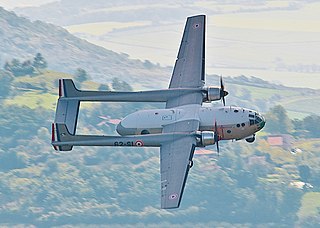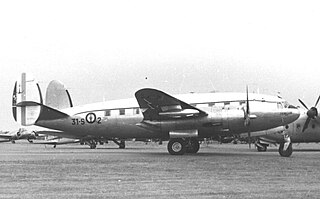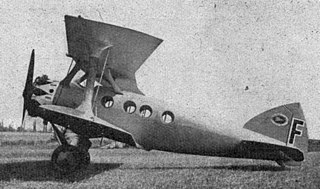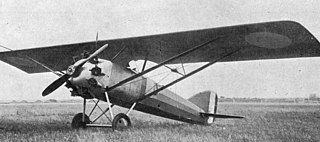Design and development
In 1945 SNCASE designed a "stratospheric" transport for transatlantic postal work designated the SE-1000. The design was not built, but after the nose section was modified, it was built as high-altitude photo-survey aircraft for the Institut Géographique National, and re-designated the SE-1010. [1] If it was decided not to use it as a survey aircraft, it was proposed to produce it as a 14-passenger transport instead. [1]
The SE-1010 was a sleek, four-engined, mid-wing monoplane powered by four Gnome-Rhône 14R 14-cylinder two-row air-cooled radial engines. The prototype SE-1010, with French test registration F-WEEE, first flew on 24 November 1948. [1] On 1 October 1949 the prototype entered a flat spin during test flying from Mariganne and crashed, killing the six person crew near Carcès. The project was canceled and the three aircraft being built were not completed. [1]

The SNCASE S.E.2010 Armagnac was a large French airliner of the late 1940s built by SNCASE (Sud-Est). The aircraft's disappointing performance and range prevented it from achieving commercial success. Although the SNCASE Armagnac did not have a sterling career, its passenger compartment design gave it a much roomier feel and greater capacity and foreshadowed the future wide-body jet airliners.

The Bloch MB.162 was a French four-engine, long-range bomber developed by Société des Avions Marcel Bloch in the late 1930s. Only a single prototype was built; after capture by German forces, it was pressed into service with the Luftwaffe as a transport.

The Nord Noratlas is a dedicated military transport aircraft, developed and manufactured by French aircraft manufacturer Nord Aviation.

The Sud-Ouest S.O.30 Bretagne was a 1940s French airliner built by Sud-Ouest.

The Latécoère 631 was a civil transatlantic flying boat built by Latécoère, the largest ever built up to its time. The type was not a success, being unreliable and uneconomic to operate. Five of the eleven aircraft built were written off in accidents and one was lost during World War II.

The Breguet 761/763/765 are a family of 1940s and 1950s French double-deck transport aircraft produced by Breguet Aviation. The aircraft were normally called the Deux-Ponts (Double-Decker) but it was not an official name.

The Blériot-SPAD S.56 was a family of French airliners developed in the 1920s as various refinements of the S.33 design. All S.56 versions shared two new features: the first was a newly designed, all-metal wing, replacing the wooden wing of earlier related designs and the second was a redesigned passenger cabin, replacing the S.33's four single seats in a row with two rows of double seats. A second access door was also added.

The Bréguet 730 was a French flying boat of the 1930s. Built to meet the requirements of the French Navy, it was ordered into production but no aircraft were delivered before France surrendered to Germany in June 1940. Four remaining incomplete airframes were completed after the end of World War II, serving with the French Navy until 1954.

The Gourdou-Leseurre GL.30 was a racing aircraft built in France in 1920 which formed the basis for a highly successful family of fighter aircraft based on the same design.

The SNCASE SE.161 Languedoc was a French four-engined airliner produced by SNCASE (Sud-Est). Developed from the Bloch MB.160 and known in the late 1930s as the (SNCSO) Bloch MB.161, the SE.161 was in service with Air France and the French military after World War II.

The SNCASE SE.100 was a French two-seat, twin-engined fighter that first flew in 1939. Mass production was planned to begin late in 1940 but the Fall of France prevented this.

The SNCAC NC.211 Cormoran was a large four-engined military transport aircraft for passengers and cargo designed and built by SNCAC from 1945.

The Sud-Est SE.200 Amphitrite was a flying boat airliner built in France in the late 1930s, originally developed as the Lioré et Olivier LeO H-49 before the nationalisation of the French aircraft industry. It was a large, six-engine design with a high-set cantilever monoplane wing, and twin tails. It was developed in response to a French air ministry specification of 1936 for a transatlantic airliner for Air France with a range of 6,000 km (3,700 mi) and a capacity for 20 passengers and 500 kg of cargo. Designs were submitted by Latécoère, Lioré et Olivier and by Potez-CAMS as the Laté 631, LeO H.49 and the Potez-CAMS 161 respectively, and examples of all designs were approved for construction. A large mock-up, resting on simulated water, was displayed at the 1938 Salon de l'Aéronautique.
The Bréguet 890 Mercure was a late 1940s French cargo and passenger transport aircraft designed by Bréguet Aviation. Three variants were produced including a military variant called the Mars but none entered production.
The Bréguet 500 Colmar was a 1940s French airliner designed by Bréguet Aviation. Two prototypes were built during the Second World War but only one survived to fly in 1945. The prototype went on to operate as a VIP transport with the French Air Force but no others were built.
The SNCASE SE-400 was a prototype French twin-engined coastal patrol floatplane of the Second World War. A single example was flown, but development was abandoned in May 1940 owing to the German invasion of France.

The Nord 260, built in prototype form as the Max Holste MH.260 Super Broussard,, was a turboprop-powered, uprated version of the piston-engined Max Holste MH.250 Super Broussard, that was further developed into the Aérospatiale N 262.
The PZL.45 Sokół (falcon) was a Polish prototype fighter designed by PZL from 1936–1939. Work commenced on the aircraft in the late 1936 based on earlier light fighters.
The SNCASE SE-1210 was an experimental French flying-boat designed and built by SNCASE as a flying scale model of the proposed SE-1200 transatlantic flying boat.
The SNCAO CAO.700 was a French prototype four-engined bomber of all-metal construction, developed shortly prior to and during the Second World War. Only a single example was built, and was on the point of being flown for the first timewhen the surrender of France in June 1940 ended testing and development of the aircraft.
This page is based on this
Wikipedia article Text is available under the
CC BY-SA 4.0 license; additional terms may apply.
Images, videos and audio are available under their respective licenses.















